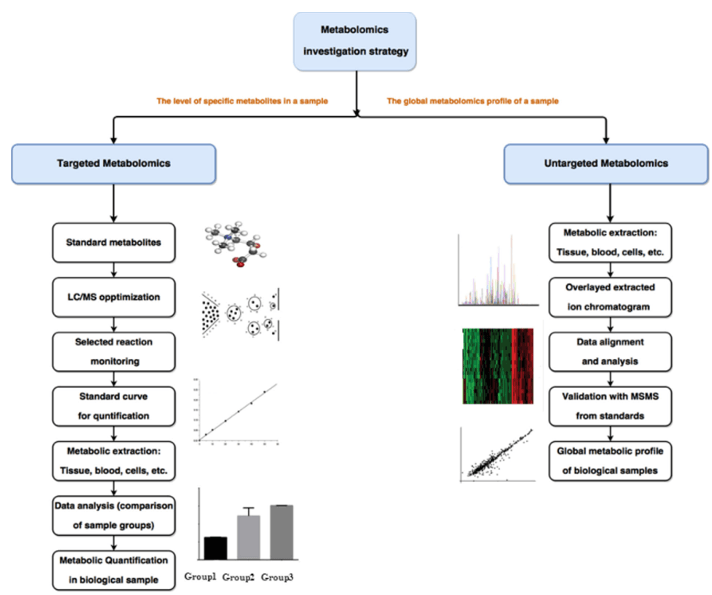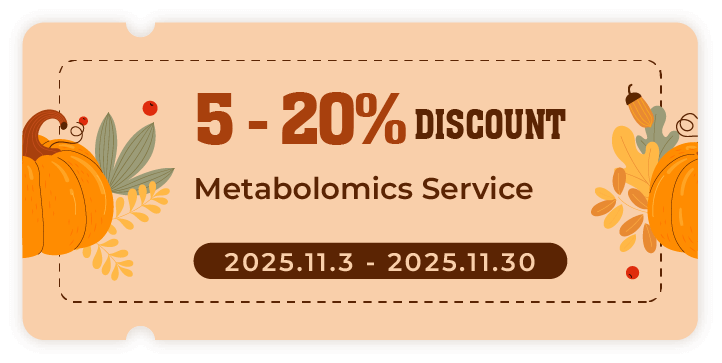Porphyrin Metabolism Analysis Service
Submit Your InquiryWhat is Porphyrin?
Porphyrins are a class of organic compounds characterized by a unique ring structure called the porphyrin ring. The porphyrin ring consists of four pyrrole units linked together by hypomethyl bridges. These pyrrole units are five-membered rings containing four carbon atoms and one nitrogen atom.
The central metal ion within the porphyrin ring is usually iron (Fe), but it can also be magnesium (Mg), zinc (Zn), or other transition metals. The coordination of the metal ion to the nitrogen atom in the porphyrin ring is critical to the functional properties of the porphyrin.
Porphyrins and their derivatives have a variety of biological functions. They are involved in processes such as oxygen binding and transport, electron transfer, enzymatic reactions, and regulation of gene expression.
Porphyrin Metabolism
Porphyrin metabolism is the series of enzymatic reactions involved in the synthesis, degradation, and conversion of porphyrins and their derivatives in living organisms. Porphyrins are cyclic organic compounds with a unique structure consisting of four pyrrole rings linked together by methine bridges.
The key metabolites in porphyrin metabolism include heme, biliverdin, and bilirubin. Heme is an essential component of various proteins, such as hemoglobin and myoglobin, and plays a critical role in oxygen transport and storage. Biliverdin and bilirubin are breakdown products of heme and are involved in the metabolism and excretion of heme-derived compounds.
Porphyrin metabolism follows a complex pathway involving multiple enzymes and intermediates. The synthesis of porphyrins begins with the condensation of glycine and succinyl-CoA to form 5-aminolevulinic acid (ALA), which is further converted into porphobilinogen (PBG). PBG is then converted into hydroxymethylbilane (HMB) and uroporphyrinogen III, which undergo subsequent enzymatic reactions to form coproporphyrinogen III and protoporphyrinogen IX. Finally, protoporphyrinogen IX is converted to protoporphyrin IX, which chelates with a metal ion, typically iron, to form heme.
The study of porphyrin metabolism provides insight into the fundamental biological processes and pathways involved in the synthesis, degradation, and transformation of porphyrins. Understanding the enzyme-catalyzed reactions and regulatory mechanisms of porphyrin metabolism contributes to our understanding of cellular physiology and metabolism. By examining the levels and characteristics of porphyrins in different tissues and organisms, researchers can explore the involvement of porphyrins in oxygen transport, electron transfer, enzyme-catalyzed reactions, and gene regulation. In addition, porphyrin metabolism analysis can help identify new enzymes, metabolites, and regulatory pathways associated with porphyrin metabolism. By characterizing enzymes related to porphyrin synthesis, degradation, and modification, researchers can identify new therapeutic targets and develop strategies for intervening in porphyrin metabolism, providing new avenues for biomedical applications.
Creative Proteomics provides customer-tailored porphyrin metabolism analysis service with rapid experimental procedures and easy to read report, to accelerate your scientific research.
Porphyrin Metabolism Analytical Platforms
Porphyrin metabolism analysis often involves the use of mass spectrometry (MS)-based techniques, which offer high sensitivity, specificity, and the ability to provide structural information about porphyrin molecules.
Liquid Chromatography-Mass Spectrometry (LC-MS): LC-MS combines liquid chromatography separation with mass spectrometry detection. High-performance liquid chromatography (HPLC) is coupled with a mass spectrometer to separate and analyze porphyrin metabolites.
- Triple Quadrupole Mass Spectrometers
- Time-of-Flight Mass Spectrometers (TOF-MS)
Matrix-Assisted Laser Desorption/Ionization Mass Spectrometry (MALDI-MS): MALDI-MS is a technique that uses a laser to desorb and ionize analytes from a solid matrix. MALDI-MS is particularly useful for analyzing intact porphyrin molecules, providing information on their mass-to-charge ratio (m/z) and allowing for structural elucidation.
- MALDI-Time-of-Flight Mass Spectrometers (MALDI-TOF-MS)
Electrospray Ionization Mass Spectrometry (ESI-MS): ESI-MS is a widely used technique for porphyrin analysis. It involves the generation of ions in solution by electrospray ionization and their subsequent introduction into the mass spectrometer. ESI-MS is suitable for both qualitative and quantitative analysis of porphyrin metabolites.
- Quadrupole-Time-of-Flight Mass Spectrometers (Q-TOF-MS)
Workflow Porphyrin Metabolism Assay
Sample Collection and Preparation: Depending on the goals of the study, gather the necessary biological samples, such as blood, urine, or tissues. To guarantee sample integrity, make sure adequate sample collecting techniques are followed. If required, keep the samples in a low-temperature environment and away from light to prevent deterioration.
Porphyrin Extraction: Extract porphyrins from the collected samples using suitable extraction methods. Various extraction techniques, such as liquid-liquid extraction, solid-phase extraction, or protein precipitation, can be employed depending on the sample type and desired level of sensitivity. The goal is to isolate and concentrate the porphyrins from the sample matrix for subsequent analysis.
Analytical Analysis: Analyze the extracted porphyrins using suitable analytical techniques, such as high-performance liquid chromatography-mass spectrometry (LC-MS), matrix-assisted laser desorption/ionization mass spectrometry (MALDI-MS), and electrospray ionization mass spectrometry (ESI-MS). These techniques offer high sensitivity, specificity, and the ability to provide structural information about porphyrin molecules.
Data Interpretation and Analysis: Interpret and analyze the obtained data to quantify porphyrin levels, identify specific porphyrin species, and characterize their profiles. This step may involve comparing the obtained data with reference standards, constructing calibration curves, and performing statistical analysis. Data interpretation helps in understanding the metabolic status, identifying any abnormalities, and drawing meaningful conclusions.
Data Validation and Quality Control: Implement appropriate quality control measures throughout the assay to ensure accurate and reliable results. This includes using appropriate standards, controls, and replicates. Validate the assay through method validation experiments, such as accuracy, precision, linearity, and limit of detection/quantification assessments, to ensure the robustness and reliability of the assay.
Reporting and Documentation: Document all the steps, procedures, and results of the assay for future reference and potential publication. Prepare a comprehensive report summarizing the assay design, methods, results, and interpretations. It is important to maintain detailed records of the assay workflow, including sample information, extraction protocols, analytical parameters, and data analysis procedures.
 Figure 1. The overall workflow of porphyrin and chlorophyll metabolism
Figure 1. The overall workflow of porphyrin and chlorophyll metabolism
List of Porphyrin Metabolism Pathways and Metabolite Analysis
| Porphyrin Metabolism Pathways | Metabolite Analysis |
|---|---|
| Porphyrin Biosynthesis | 5-Aminolevulinic Acid (ALA) Porphobilinogen (PBG) Hydroxymethylbilane (HMB) Uroporphyrinogen III Coproporphyrinogen III Protoporphyrinogen IX Heme |
| Porphyrin Degradation | Heme Biliverdin Bilirubin |
| Porphyrin Metabolite Analysis | Porphyrin Profiling Porphyrin Quantification Porphyrin Structure Elucidation Porphyrin Flux Analysis Porphyrin Biomarker Discovery |
Sample Requirements
We can analyze a wide range of biological materials including but not limited to cells and solid tissues from animals. If you need transport your samples to us, please follow the following requirements for different types of sample:
- Blood/plasma: 500ul/sample
- Urine: 1ml/sample
- Tissue: 200mg/sample
- Cells: 1x107/sample
- Feces: 500mg/sample
Shipment condition: dry ice
Report Delivery
- Experimental protocols
- Instrumental factors of HPLC
- The raw data files of HPLC and the summary of HPLC data quality
- Bioinformatics analysis report
References
- E. Pérez-Urria, A. Avalos. Approach to a comparative study of the metabolism of porphyrins and chlorophylls. J Nat Sci. 2015.3:1-16.
- Rumpho Mary E, Pelletreau Karen N, Moustafa Ahmed et al. The making of a photosynthetic animal. J Exp Biol. 2011.214:303-311.







